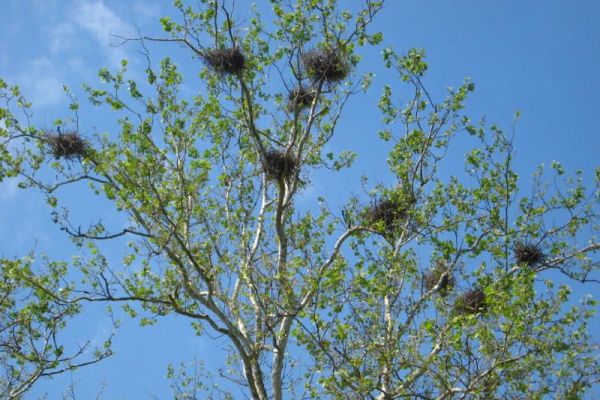
If you know of a heron rookery in Pennsylvania, the Game Commission needs your help.
From now through the end of May the Game Commission is conducting a survey of heron nesting colonies in the state to keep tabs on the birds and make sure they are doing well.
Want to help? Here are the birds to look for. Click on the links to see their pictures.
- Great blue herons nest high in trees near water. You’ll often find their large stick nests in sycamores, as shown above. They are fairly secure and abundant in Pennsylvania so they are monitored in five year intervals rather than annually. Their presence is an indication of high quality habitat.
- Black-crowned night herons are the most widespread heron in the world but they’re on Pennsylvania’s state endangered list because their population has declined here in recent decades. Like great blue herons they nest in trees near water but are more willing to nest near humans.
- Yellow-crowned night-herons are rarer in Pennsylvania than their black-crowned cousins because our state is at the northern edge of their range. They too are on the state endangered species list. Their nesting colonies are found only along PA’s lower Susquehanna River.
If you know of a heron colony or happen upon one, you can help by monitoring and reporting what you see. The complete instructions are at this link. Here’s a summary:
- Don’t approach the nests! Stay 100 yards away (that’s the length of a football field).
- Use your binoculars to monitor the nests. If you disturb the colony it defeats the purpose of the survey.
- Take notes:
- Where is the colony located?
- What is the habitat like?
- Are the trees alive or dead?
- Count the nests. How many are there? How many are active?
- Note activity at the nests: Adults standing on the nests? Adults delivering food? Chicks poking their heads up?
- Are there any threats to the colony? Predators? Human encroachment?
- Fill out this form and send your observations to herondata@gmail.com
- Don’t assume someone else has reported the colony. You may be the only one to send in the data!
To get involved, read more about the Heron Survey here.
Hot tip: Start looking now before the trees fully leaf out!
(photo of a great blue heron nesting colony by Tim Vechter)